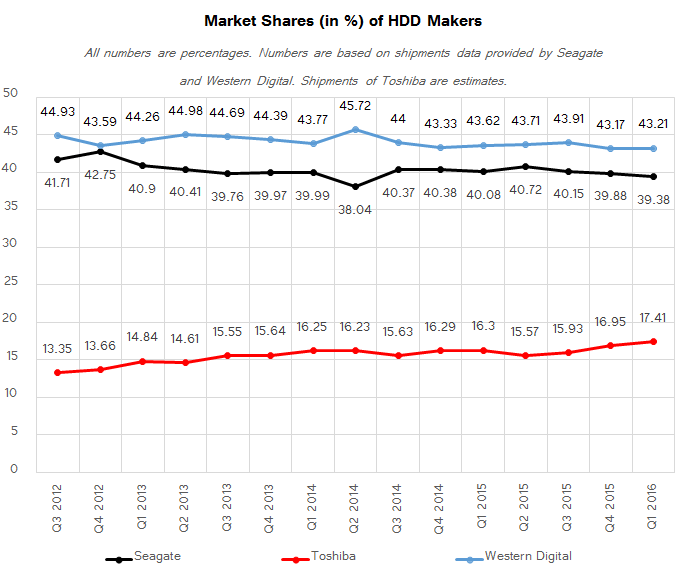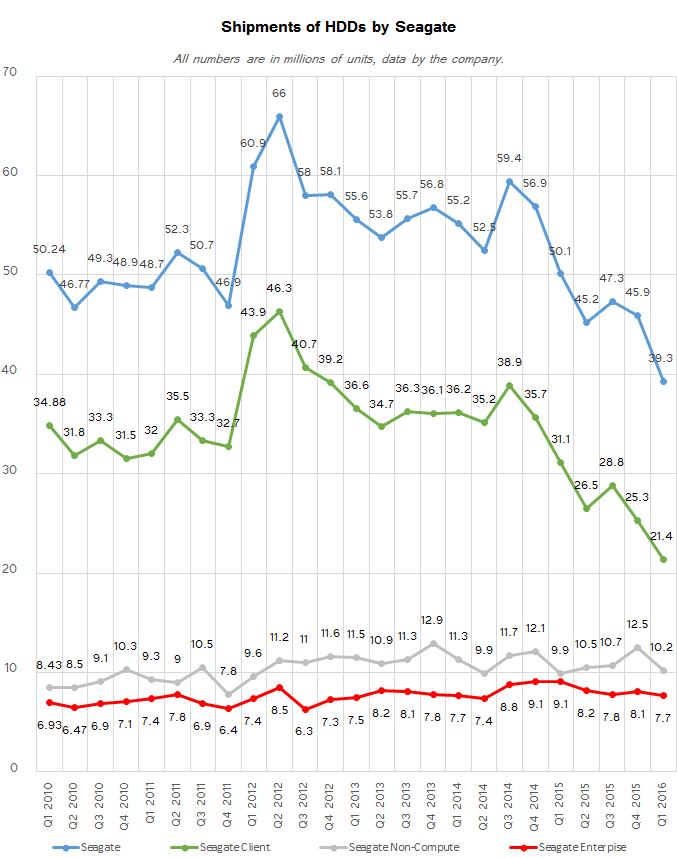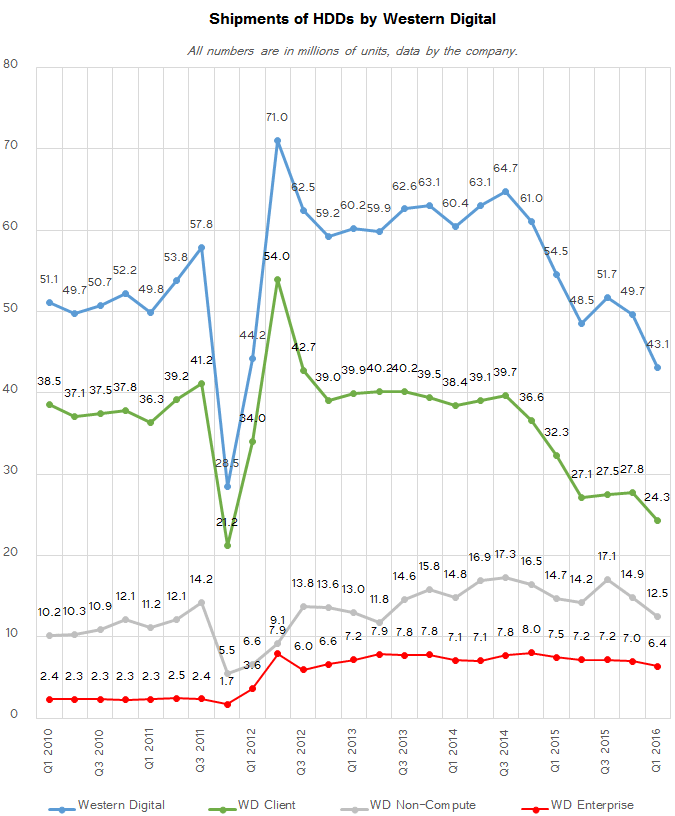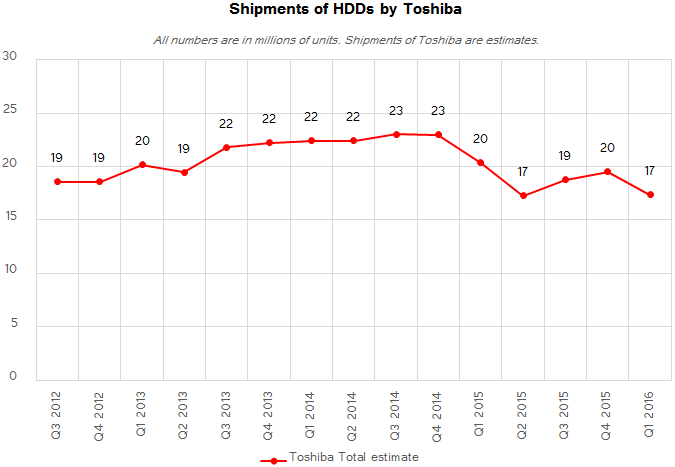Market Views: HDD Shipments Down 20% in Q1 2016, Hit Multi-Year Low
by Anton Shilov on May 12, 2016 8:00 AM ESTWestern Digital Remains World’s No. 1 HDD Supplier
Due to severe declines in demand for hard drives, it does not look like HDD makers want to fight for market share. Western Digital controlled about 43% of the HDD market in Q1 2016, just like a quarter before. Seagate was the second largest supplier with 39.38% market share. If the HDD shipments numbers for Toshiba are correct, then the company controlled around 17% of the hard drive market, moving ever so slightly higher.
Seagate’s HDD Sales Drop Below 40 Million Units, Company Plans Capacity Adjustments, Product Cuts
Seagate sold 39.3 million hard drives in the first quarter of 2016, a 21.5% decline from the same period a year ago. Sales of Seagate’s HDDs dropped across the board - with the exception of nearline drives. During the conference call with investors and financial analysts, the company particularly noted weak sales of client HDDs as well as declines in shipments of traditional mission-critical drives. Moreover, in a bid to maintain margins, the firm decided to “not aggressively participate in certain areas of the low capacity notebook market,” which further drove its unit sales down.
As it appears, Seagate does not seem to be confident that the hard drive market will rebound in the foreseeable future. The HDD maker intends to cut-down its manufacturing capacities from 55 – 60 million units per quarter to approximately 35 – 40 million units per quarter, which will help it to reduce operating costs and maintain prices despite competition from traditional and emerging rivals.
“In the March quarter we began the process of reducing our HDD manufacturing capacity from approximately 55 million to 60 million drives per quarter to approximately 35 million to 40 million drives per quarter,” said Steve Luczo, chief executive officer of Seagate, in a conference call with investors and financial analysts. “The actions required will be completed within the next 6 to 9 months. At the same time, we will continue to accelerate the utilization of our own drive factories internally and media facilities.”
While Seagate does not detail its capacity-cutting plans, it indicates that it intends to shift build volumes to its higher capacity models, which will simplify wafer requirements, optimize the lineup and will eventually reduce costs. In particular, the company will discontinue some of its low-capacity client HDDs (250 GB, 320 GB and 500 GB), which will help to increase its ASPs (average selling prices) and margins.
“In [Q1 2016] we began end-of-life activity on some of the older 500 GB and below products that have very low margins,” said Dave Mosley, president of operations and technology at Seagate. “Most of the margin cost benefits of these products will be realized over the next few quarters.”
In fact, Seagate began targeted pricing increases across its product portfolio already in the third quarter of its fiscal year (i.e., Q1 2016), which could help to improve its financial results. The manufacturer believes that higher HDD prices are justified because HDDs are getting harder to make. Since the company decided not to participate in some areas of the low capacity laptop market, it is evident that it may leave it to makers of entry-level SSDs in the future.
“In the March quarter we initiated targeted pricing increases across our product line, we were successful in some areas and unsuccessful in other,” said Mr. Luczo. “We continue to believe the industry needs a stable pricing environment to deliver the higher level of requirements being placed on our products and to realize the value we are providing to the market. As a result, we will continue to pursue a pricing strategy that reduces and properly reflects the investment in technology the market requires.”
Shipments of Western Digital’s HDDs Fall to 43.1 Million Units
Western Digital shipped 43.123 million of HDDs in the first three months of this year, or 21% less compared to Q1 2015. Sales of the company dropped across the board due to the weak PC market and seasonality. Just like Seagate, Western Digital increased prices of certain products during the quarter. In particular, the company hiked prices of some of its 2.5” drives for notebooks and gaming PCs (which is probably the WD Black2 Dual Drive). Right now, the company is making selective price increases in the enterprise segment in a bid to maintain its ASPs and margins and sustain its ability to invest in the development of products.
“Because we want to make sure that we have got sufficient dollars to reinvest back into our business to continue to innovate and provide compelling products for our customers, we are making selective price increases in certain enterprise markets,” said Stephen Milligan, chief executive officer of Western Digital, in a conference call with investors and financial analysts. “At this point, we are not sure if they're going to stick, but we are certainly hoping that they do.”
Earlier this year Western Digital announced plans to optimize its roadmap and close-down its head wafer manufacturing facility in Otawara, Japan, in a bid to reduce costs and maintain its profitability. So far, the company has not announced plans to reduce its HDD manufacturing capacities significantly but said it would eliminate redundant facilities. The company also did not make any comments regarding the future of its low-end HDDs.
Toshiba’s HDD Shipments Drop Too
Since Toshiba does not disclose anything related to its hard drive business, it is hard to analyze this supplier. If estimations of HDD makers and Nidec are correct, then Toshiba’s HDD shipments in Q1 2016 should be around 17 million units, or 15% below its shipments in the same period last year.














116 Comments
View All Comments
Gothmoth - Thursday, May 12, 2016 - link
HDD´s drop dead like flies... no wonder nobodys want´s to buy that crap.seagate is replacing my 3 month old 4TB drive with a FACTORY REPAIRED drive.
i did not pay for a second hand drive!!!
WD is not much better.
seagate cheats their customers with their crappy warranty.
jwcalla - Thursday, May 12, 2016 - link
I agree. It's one of the reasons I'm hesitant to buy any. Most of them are complete junk.SirGCal - Friday, May 13, 2016 - link
Test your drives before use. Especially Seagates. Their build practices frighten me. I have 8 4TB drives, and went through 22 drives before I got 8 that passed the tests... THAT is scary. But they've been running since release without further issues. I hear they are far better now but I still test each one before using it.jbrizz - Sunday, May 15, 2016 - link
You can probably thank weak consumer protection laws for that. In AU and NZ (and probably UK and other parts of Europe) they don't do that because it's not legal.svan1971 - Thursday, May 12, 2016 - link
The price has not gone down though...sonicmerlin - Thursday, May 12, 2016 - link
That's because the $/GB has barely budged since what it was at before the 2011 flood. I remember routinely seeing 3 TB internal HDDs going on sale for $80 before the flood.Then the HDD vendors all merged and jacked up prices while massively slowing down aerial density innovations.
SirGCal - Friday, May 13, 2016 - link
Hu? They are up to 10TB drives now in test cases and 8TB regularly purchasable... It's only 2016. Plus the cost of components has changed. I'd consider the 2011 pre-flood an all time low, rather amazing prices then a norm to aim for... Still I never saw a 3TB drive I'd buy, let alone one for that price.Burns101 - Thursday, May 12, 2016 - link
HDDs are only good for porn and movies!iwod - Thursday, May 12, 2016 - link
You can now get a very decent Plextor M7V ( TLC Based ) or SanDisk SSD Plus ( MLC Based ), both with decent Controller and Firmware support for less then $40 with 128GB.I expect the price to stay put, in 2017 once all the Fab from China and New Fab from Samsung are up, we will likely see 256GB SSD going for $40 in 2018. That should be the point where most people are fine with SSD in terms of capacity.
stevenrix - Friday, May 13, 2016 - link
The hard-drive market going down sounds like a predictive failure from their own technical jargon.It was worth mentioning that the price per gig on the hard-drives won't go down, which means that at some point in time, when the prices of the hard-drive will go up according to their bigger capacity (10 Tb, 12 Tb ...etc) and the price of the SSDs going down, then it will make it easier to switch to SSDs. In other words their strategy won't resist that much in time. Also if prices since the flood in Thailand have not much fluctuated on the hard-drives makers, the cost on the consumer went from 1 to 3 for the same hard-drive capacity. A few days before the flood I had bought around 20 Tb of drives for a few hundreds of dollars, and i have never seen those prices going back to those prices and it probably will never go back to that trend.
At a consumer level, I am willing to upgrade to 8Tb drives, but those prices are too expensive. I am pretty sure that many consumers are waiting to upgrade to bigger drives and are waiting to see the prices getting slashed. Worse case scenario I will keep buying 4 Tb drives. It is the enterprise market that help the hard-drives makers to survive, especially in the NAS enterprise market (a SAS 6 15K drive costs so much money). Maybe they should not cut production, but help to replace failed hard-drives with newer hard-drives instead of refurbished drives that will fail again in a few weeks/months to raise customer's satisfaction, because customer's satisfaction dropped to low levels a few years ago. Please make the customer happy first and they'll start buying again hard-drives. Thanks ;)